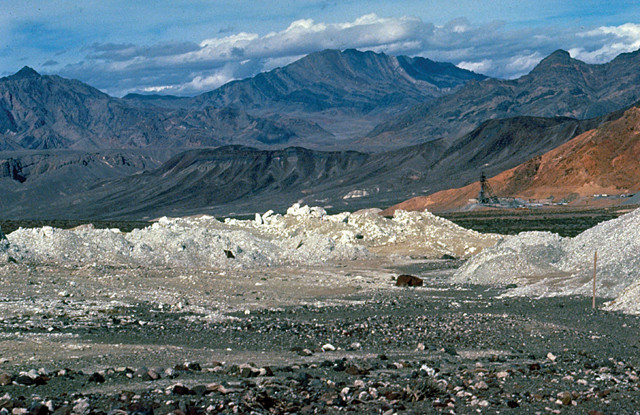
by U.S. Geological Survey Wednesday, June 13, 2018
Robert D. Crangle, Jr., mineral commodity specialist for the U.S. Geological Survey, compiled the following information on boron, an essential commodity for the ceramic, detergent, fertilizer and glass industries.

Borate mine in California. Credit: ©Marli Miller, University of Oregon, ESW Image Bank
Elemental boron is a metalloid that has limited commercial applications. But boron compounds, chiefly borates, are commercially important; therefore, boron products are priced and sold based on their boric oxide content, varying by ore and compound and by the absence or presence of calcium and sodium. Four borate minerals — colemanite, kernite, tincal and ulexite — make up 90 percent of the borates used by industry worldwide.
Borate deposits are associated with volcanic activity and arid climates, with the largest borate deposits located in three locales: the Mojave Desert of the United States, the Tethyan belt in southern Asia, and the Andean belt of South America. As a result, most borates are extracted primarily in California and Turkey and, to a lesser extent, in Argentina, Bolivia, Chile, China and Peru. Boron compounds and minerals are produced by surface and underground mining and from brine. The United States holds nearly one-fifth of world resources of boron and is a net exporter.
Although borates are consumed in more than 300 end uses, about 75 percent of the world’s supply is sold for use in ceramics, detergents, fertilizer and glass. In the U.S., ceramics and glass make up about 80 percent of end consumption. The remaining end uses are bleaches, detergents and soaps at 4 percent; agriculture at 4 percent; enamels and glazes at 3 percent; and hundreds of other uses make up the remaining 9 percent.
The global economic crisis of late 2008 and recession of 2009 negatively affected sectors vital for boron consumption, such as the automotive and construction industries. The moderate economic recovery in 2010 resulted in growth in boron production and consumption. Consumption of borates is expected to increase in the coming years, spurred by strong demand in the Asian and South American agricultural, ceramic and glass markets, assuming little substitution.
The substitution of other materials for boron is possible in detergents, enamel, insulation and soaps. Sodium percarbonate can replace borates in detergents but requires lower temperatures to undergo hydrolysis, which is an environmental consideration. Some enamels can use other glass-producing substances, such as phosphates. Insulation substitutes include cellulose, foams and mineral wools. In soaps, sodium and potassium salts of fatty acids can act as cleaning and emulsifying agents.
For more information on boron and other mineral resources, visit: minerals.usgs.gov/minerals.
Boron production and consumption
Two mines produced all borates mined in the United States in 2010.
Nine countries mined boron in 2010, with Argentina, Chile, Russia, Turkey and the United States the world’s leading boron producers.
In 2010, the average value of boron imports was estimated at $361 per metric ton.
In 2010, the United States exported 760,000 metric tons of boric acid and refined sodium borates to more than 25 countries and imported more than 36,000 metric tons of sodium borates from 13 countries, with Turkey accounting for half of imports.
Fun facts
The first reported use of borax was as a bonding agent by Arabian gold- and silversmiths in the 8th century A.D.
Boron is the most widely used agricultural micronutrient, applied primarily to promote fruit and seed production.
Ferroboron is used in the production of neodymium-iron-boron magnets, which possess the highest strength of all magnets. They are used in computer hard drives, guidance systems and wind turbines.
Boron carbide is a key ingredient in lightweight bulletproof armor and Kevlar® flak jackets.
© 2008-2021. All rights reserved. Any copying, redistribution or retransmission of any of the contents of this service without the expressed written permission of the American Geosciences Institute is expressly prohibited. Click here for all copyright requests.